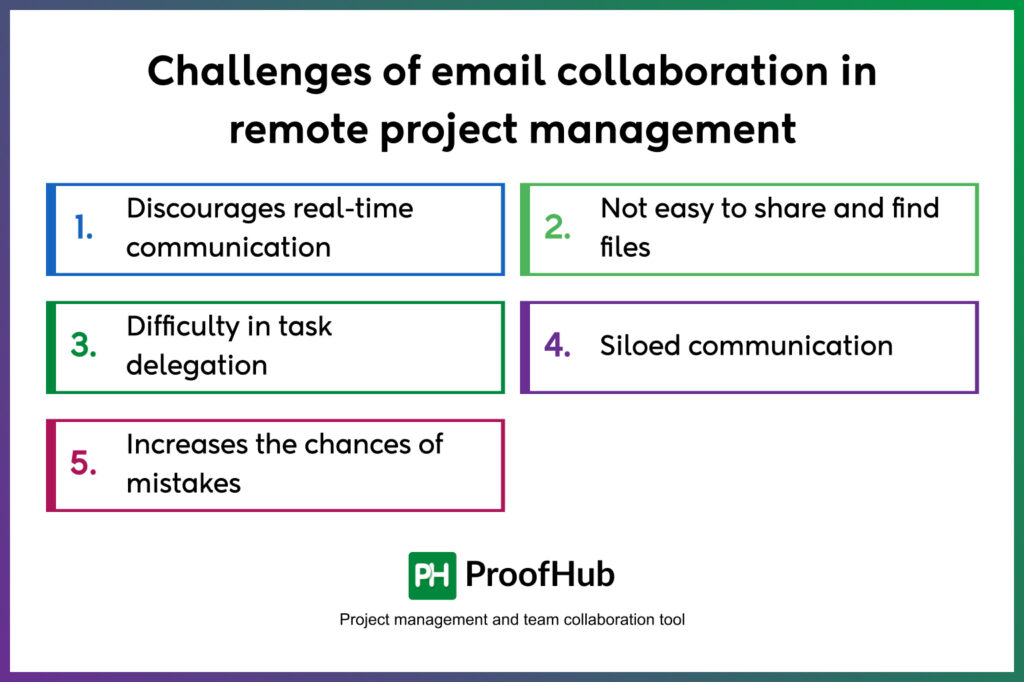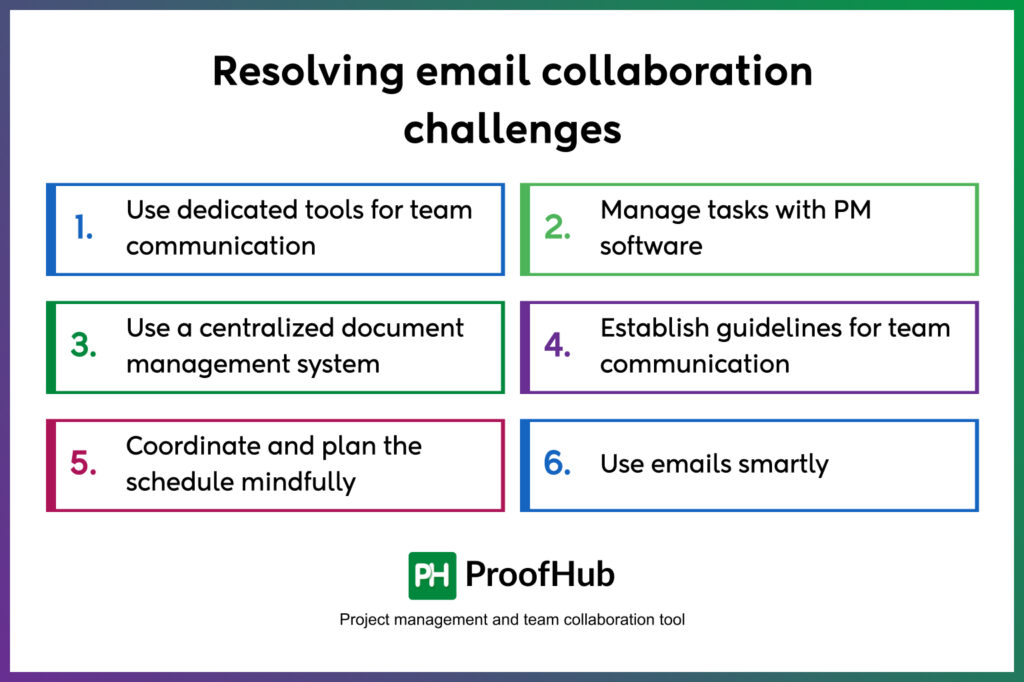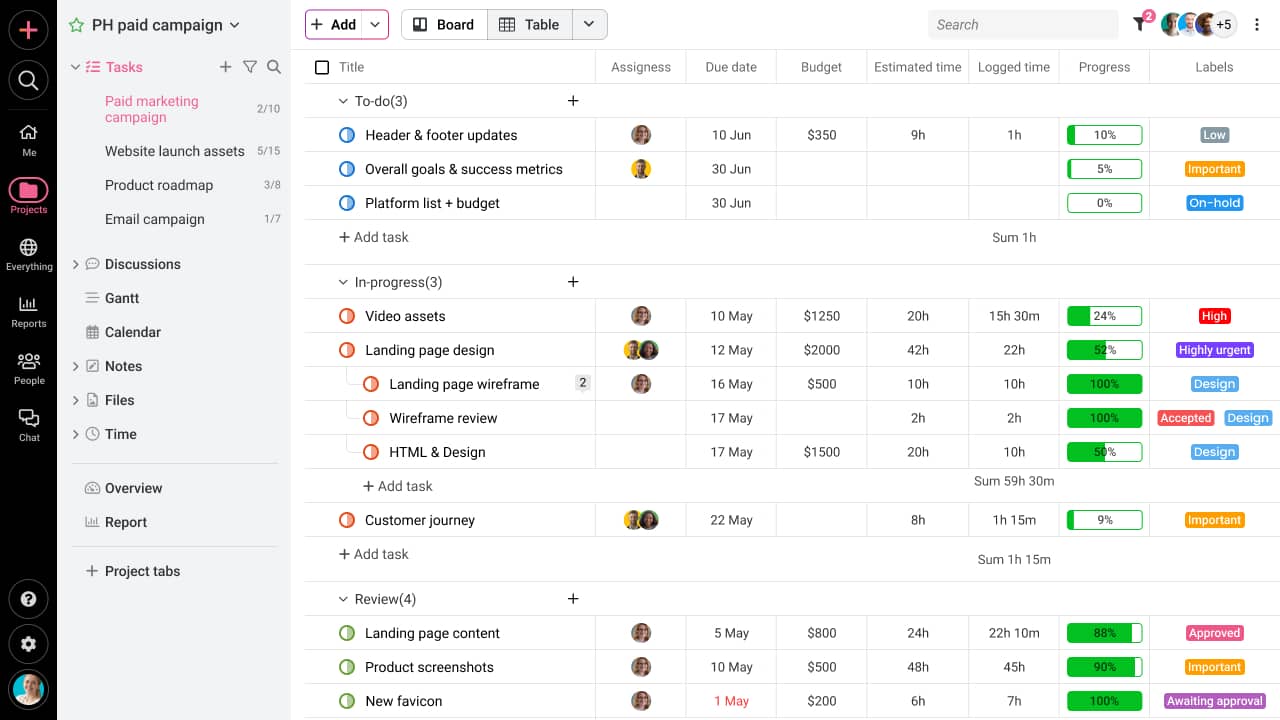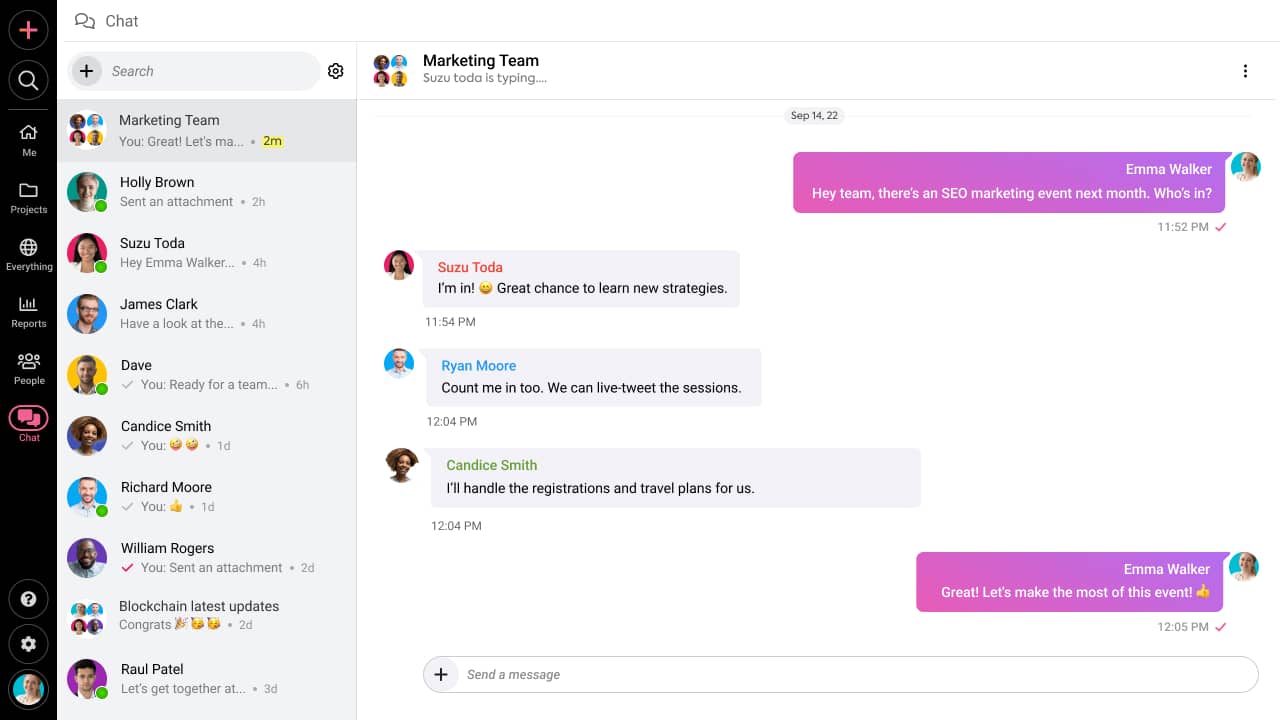Relying on email collaboration for remote project management is one of the worst productivity-killing mistakes one can make.
Why?
Email overload takes hours of time and effort to deal with.
Long email discussion threads take a toll on one’s energy and calm.
Searching your Inbox to find that crucial attachment that you sent 3 months ago is like fishing in the sea. You do not know when you will find it.
The list of email collaboration challenges in remote project management goes on…
These challenges waste your time and make your work life difficult. Trust me, I have been there. It becomes very important to address and solve these email collaboration challenges in remote project management on priority.
After leading virtual teams across multiple time zones for over thirteen years, I have discovered strategies to combat this productivity killer with more efficient solutions, effectively conquering these challenges.
Let’s delve into the details.
What is remote project management?
Remote project management is just like traditional project management — it’s just that some or all of your team members are working remotely. It is a blend of traditional project management with remote collaboration.
You use the same processes, same techniques, and try to achieve the same objectives with project management, but the means of communication and collaboration are different.
Remote working came to the rise after the COVID-19 pandemic, but now, it has become a norm.
87% of employees say when offered remote work, they will take the opportunity to work flexibly. Thus, sooner or later you have to shift to remote work management.
In a traditional working environment, your team is present in the office. It is easy to collaborate and communicate with them.
Whereas, in a remote working environment, your team is present at different locations across the globe and may work in different time zones. It gets challenging to communicate and collaborate with them.
You need digital collaboration tools to collaborate with your remote team.
Challenges of email collaboration in remote project management

Collaboration happens when a team works together. And working together means, team members have to coordinate and share information to work towards one goal.
Email makes it very difficult due to its design. It is designed for one-to-one collaboration, not for real-time group collaboration.
For example, just a 10-minute group communication between 5-7 members on a task on an email can become a difficult discussion thread to sift through.
This results in highly inefficient collaboration that kills productivity and leads to miscommunication making it difficult to work together.
Have a look at some of the other key remote collaboration challenges you face while managing projects remotely with emails.
1. Discourages real-time communication
In remote working, you cannot go to someone’s desk to discuss task details, share information, and discuss ideas. You have to rely on your online communication tool for the collaboration.
Email does not provide a good platform for seamless real-time team communication. You have to draft an email for every message, long email threads make it difficult to keep track of the conversation, and one can easily skip a message due to such a huge volume of emails.
It is highly likely that email communications get misinterpreted when it comes to criticism as it does not have interactive elements in it.
All of this makes group communication extremely difficult with emails and discourages people from participating in conversation.
2. Not easy to share and find files
More than 50% of office pros spend more time searching for files than on work.
File sharing is an important aspect of remote working. Email does not provide you with an efficient platform to share, store, access, and find files.
For example, if you have to search for an old file from your email inbox, you might have to go through hundreds of emails even after using inbox search. This can kill hours of your productivity every day.
Not to forget the incapability to share large files and file versioning issues. You cannot easily share files of size more than 25 MB per email. It takes time to upload files and download them. Above all, it is difficult to track file versions.
3. Difficulty in task delegation and tracking progress
According to a study by Adobe, an average person spends as much as three hours a day managing their work email.
Creating and delegating tasks is the primary purpose of using emails in remote project management. This works fine when you are working with a team of four to five people with a small number of projects.
But when your team grows or you have multiple teams and a large number of projects to handle, the task delegation becomes extremely difficult.
You have to draft an email every time you want to create a task, add details, send emails to recipients, and so on. The whole process becomes so time-consuming that you will not be able to focus on the important tasks.
Apart from task delegation, keeping track of the assigned tasks with emails is hard. You have no transparency of the work status.
4. Siloed Communication
According to Gartner research, poor communication is responsible for 70% of corporate errors.
For effective team collaboration, it is important that a team communicate with each other well. The nature of email collaboration is such that it results in siloed communication.
A manager may not be aware of the team communication happening between the team members or a team member of one department may not be aware of what team members of another department are working on.
This resulted in working in silos, duplication of the work, less transparency, lack of collaboration, and wasted efforts.
5. Increases the chances of mistakes
Receiving all sorts of emails including work, client, team, and social in your one inbox can easily turn it into chaos. This increases the chances of missing important emails leading to delays and miscommunication.
Even the filters or establishing rules cannot help you much when you receive such a huge volume of emails every day.
Also, not to forget the phishing emails that can put your company’s security at stake. Because it is hard to identify the fishy emails when you are receiving hundreds of emails every day.
Read More: 7 Good Reasons Project Managers Should Ditch Email Communication
These are the five main challenges you face when you use emails for remote project management. Now, let’s have a look at the strategies to resolve these challenges.
Strategies for overcoming email collaboration challenges for remote project management

Using emails for collaboration in remote project management poses challenges primarily with three aspects: managing tasks, team communication, and sharing files. Additionally, email management challenges can complicate these aspects further.
I have mentioned six tested strategies to encounter these challenges successfully that will help you improve your productivity.
1. Use dedicated tools for team communication
For successful remote collaboration, it is very important you have dedicated channels for communication to replicate the ease of in-office communication.
You can use dedicated communication tools such as chat and video conferencing apps for team communication.
These tools help you reduce your reliance on emails for day-to-day regular conversations.
Video conferencing apps will help you with video and audio team meetings. Chat will help you with regular real-time one-to-one and group communication with teams and clients.
2. Manage tasks with project management software
Project management software eliminates the need to use emails for task management. It provides you with a wide range of features to help you manage your work.
You can create tasks, add the details required to complete a task, assign tasks to the team members, track progress in real time, and collaborate on tasks with team members from a centralized place.
Every team member can log in to their account and use the project management software to work together.
Read more: 7 Good Reasons To Replace Email With Project Management Software
3. Use a centralized document management system
For effective remote collaboration, having a centralized document management system is as important as having a project management system and team communication system.
Use a cloud-based storage app where team members can share, store, and access files. This will help you create one place where everyone on the team can share and find files.
Read more: 11 Best Document Management Software in 2025
4. Establish guidelines for team communication
For effective team communication and to avoid confusion, it is very important to define guidelines for team communication. These guidelines can talk about:
- the primary channel for regular communication between team members
- the channel for task-specific communication
- when to use video-conferencing apps
- in which case you should use emails
- the ideal response times for emails
- and more.
This will help you streamline your team communication, avoid confusion, and ensure effective communication.
5. Coordinate and plan the schedule mindfully
When working with remote teams, it is important to be mindful of time zones and cultural differences. Be sure to schedule meetings and deadlines at times that are convenient for everyone on the team. Additionally, be respectful of cultural differences in communication styles and preferences.
6. Use emails smartly
Email is not a bad tool for communication if you know its limitations and ‘how,’ ‘when,’ and ‘what for’ to use it. Use emails smartly for high-priority, task-critical, and formal conversations that you do not want everyone to know about.
You can also use hacks like filters and rules to automatically sort and organize your emails so that you waste less time managing emails.
Use time-batching techniques to spend less time on email checking and deal with email overload smartly.
Want to learn more about the similar email hacks? Check out the top 10 email project management tips
Now, you clearly understand that using emails for collaboration in remote project management kills productivity, makes it difficult to work together, and leads to costly mistakes.
And you also know that you can use the tools to stop wasting time on emails and address these challenges. Then, why not start today?
Make remote project management collaboration easy with ProofHub
ProofHub is the best all-in-one project management and team collaboration software for teams of all sizes that allows you to manage projects, streamline team communication, and collaborate on tasks from a centralized place- no matter your location.
It reduces your reliance on emails, increases productivity, and makes work-life easy. Let’s see how:
1. Centralized task management: No need to send emails back and forth to delegate tasks and request updates.
With ProofHub, you can create projects, add tasks, delegate tasks to team members, track progress in real time, and manage projects from a centralized place.

2. Centralized team communication: No more sifting through long email threads and switching to multiple platforms for communication.
With ProofHub, you can bring all the team communication to one place. You can use ProofHub chat for real-time communication, @mentions task comments to tag team members on the tasks, and project discussions to engage clients in discussions to stay on the same page.

3. Centralized document management and organization: No need to spend hours on finding attachments through inbox.
ProofHub centralized document sharing allows you to directly attach files to the tasks from the computer, Google Drive, or more. It helps you organize, store, and access documents from a centralized place.
4. Real-time notifications: ProofHub sends real-time notifications to team members when they are mentioned in comments, assigned tasks, or when files are updated.
This helps to ensure that everyone is kept up-to-date and no information slips through the cracks.
5. Document everything: ProofHub makes it easy for team members in different time zones to collaborate on projects by documenting everything.
You can create a workflow, comment on tasks, and share information on chat. It helps them find all the information they need and work even when you are not available.
Why only ProofHub?
There are three reasons for that.
- First, it has all the features you need for your remote project management in one place.
- Second, it makes all the features you need to facilitate seamless team collaboration
- And third, it is easy to use. Everyone can learn to use it easily within a few days.
And the biggest advantage is you get all of these features for a flat fee. This means ProofHub is going to be a scalable solution for your business.
Considering the productivity-killing and time-consuming mistakes in email remote project management, ProofHub would be a worthy investment to improve productivity and make your work life easy.
FAQs
What are the drawbacks of relying solely on email for remote project collaboration?
There are many drawbacks of relying solely on email for remote project management that kill productivity and make work life difficult. It includes no real-time communication between the team, time wasted on communication, chances of miscommunication, conflicts, lack of accountability, and inefficient collaboration.
How do you handle communication and collaboration with remote team members or virtual teams?
The best way to handle communication and collaboration with remote members or virtual teams is to use digital collaboration tools and implement the best practices for team communication and collaboration. The best practices include creating dedicated channels for communication, streamlining communication, and documenting everything.
Are there specific collaboration tools recommended for remote project management?
Yes, there are many specific collaboration tools that I recommend for project management. It includes ProofHub, Google Drive, Zoom, Slack, and Calendly. These tools help you collaborate on projects, communicate in real time, and schedule meetings based on availability.
Why is there a need for improved collaboration?
It helps you work efficiently, waste less time, communicate seamlessly to share ideas, enhance teamwork, and bring transparency. The improved collaboration results in improved work quality and better control over work to complete projects within budget and time.
What are the best practices for managing a remote workforce?
The best practices for managing remote workers include regular check-ins, weekly virtual events, regular feedback sessions, respecting personal boundaries, and having light-hearted discussions with the team from time to time. It helps you stay connected to your remote team, prevent social isolation, and keep them engaged.

